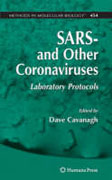
In 2003, the word 'coronavirus' spread across the globe, somewhat further than the virus that sparked the panic. In "SARS- and Other Coronaviruses: Laboratory Protocols", expert researchers examine these devastating viruses through detailed laboratory protocols. Chapters deal with such subjects as detection and discovery of coronaviruses by nucleic acid and antibody-based approaches, virus isolation, propagation and titration, virus purification, structure analysis by electron cryomicroscopy, expression and crystallization of viral proteins, raising antibodies against viral proteins, manipulation of the coronavirus genome, and descriptions of how to investigate aspects of the cell surface forcoronavirus receptors. Comprehensive and cutting-edge, "SARS- and Other Coronaviruses Laboratory Protocols" serves as an ideal guide for all virologists and especially for those working with coronaviruses. INDICE: reface Section 1. Detection and discovery of coronaviruses 1) A pancoronavirus RT-PCR assay for detection of all known coronaviruses, Leen Vijgen, Elien MoA"s, Els Keyaerts, Sandra Li, and Marc Van Ranst 2) Detection of Group 1 coronaviruses in bats using universal coronavirus reverse transcription polymerase chain reactions, Leo L. M. Poon 3) Detection and sequence characterisation of the 3' end of coronavirus genomes harbouring the highly conserved rna motif s2m, Christine Monceyron Jonassen 4) RT-PCR detection of avian coronaviruses of galliform birds (chicken, turkey, pheasant) and in a parrot. Francesca Anne Culver, Paul Britton and Dave Cavanagh. 5) Detection of group 2a coronaviruses with emphasis on bovine and wild ruminant strains: virus isolation, and detection of antibody, antigen, and nucleic acid, Mustafa Hasoksuz, Anastasia Vlasova, Linda J. Saif 6) Detection of SARS coronavirus in humans and animals by conventional and quantitative (real time) coronavirus reverse transcription polymerase chain reactions, J. S. Malik Peiris and Leo L. M. Poon 7) Detection of new viruses by VIDISCA: virus discovery based on cDNA-amplified fragment length polymorphism, Krzysztof Pyrc, Maarten F. Jebbink, Ben Berkhout and Lia van der Hoek Section 2. Isolation, growth, titration and purification of coronaviruses 8) Titration of human coronaviruses, HCoV-229E and HCoV-OC43, by an Indirect Immunoperoxidase Assay, Francine Lambert, Helene Jacomy, Gabriel Marceau, Pierre J. Talbot 9) The preparation of chicken tracheal organ culturesfor virus isolation, propagation and titration, Brenda V. Jones and Ruth M. Hennion 10) Isolation and Propagation of Coronaviruses in Embryonated Eggs, James S. Guy 11) Large scale preparation of UV-inactivated SARS coronavirus virions for vaccine antigen, Yasuko Tsunetsugu-Yokota. Section 3. Structure of CoVsanalysed by electron microscopy 12) Purification and electron cryomicroscopy of coronavirus particles, Benjamin W. Neuman, Brian D. Adair, Mark Yeager and Michael J. Buchmeier Section 4. Expression of coronavirus proteins, and crystallization 13) Production of coronavirus non-structural proteins in soluble form for crystallization Yvonne Piotrowski, Rajesh Ponnusamy, Stephanie Glaser, Anniken Daabach, Ralf Moll, and Rolf Hilgenfeld Section 5. Raising antibodies to coronavirus proteins 14) Generating antibodies to the gene 3 proteins of infectious bronchitis virus, Amanda R. Pendleton, and Carolyn E. Machamer 15) Establishment and characterization of monoclonal antibodies against SARS coronavirus, Kazuo Ohnishi 16) Production of monospecific rabbit antisera recognizing nidovirus proteins, Jessika C. Zevenhoven-Dobbe, Alfred L.M. Wassenaar, Yvonnevan der Meer, and Eric J. Snijder Section 6. Manipulating the genomes of coronaviruses 17) Manipulation of the coronavirus genome using targeted RNA recombination with interspecies chimeric coronaviruses, Cornelis A.M. de Haan, Bert Jan Haijema, Paul S. Masters, and Peter J.M. Rottier 18) Generation of recombinant coronaviruses using vaccinia virus as cloning the vector, and stable celllines containing coronaviral replicon RNAs Klara K. Eriksson, Divine Makia, and Volker Thiel 19) Transient Dominant Selection for the Modification and Generation of Recombinant Infectious Bronchitis Coronaviruses, Maria Armesto, RosaCasais, Dave Cavanagh, and Paul Britton. 20) Engineering infectious cDNAs of coronavirus as bacterial artificial chromosomes, Fernando Almazan, Carmen Galan and Luis Enjuanes 21) Systematic Assembly and Genetic Manipulation of the Mouse Hepatitis Virus A59 Genome. Eric F. Donaldson, Amy C. Sims, and Ralph S. Baric Section 7. Identifying coronavirus receptors 22) Identification of sugar residues involved in the binding of TGEV to porcine brush border membranes, Christel Schwegmann-Wessels and Georg Herrler 23) Pseudotyped vesicular stomatitis virus for analysis of virus entry mediated by SARS coronavirus spike proteins, Shuetsu Fukushi, Rie Watanabe, Fumihiro Taguchi.
- ISBN: 978-1-58829-867-6
- Editorial: Humana
- Encuadernacion: Cartoné
- Páginas: 385
- Fecha Publicación: 01/06/2008
- Nº Volúmenes: 1
- Idioma: Inglés
